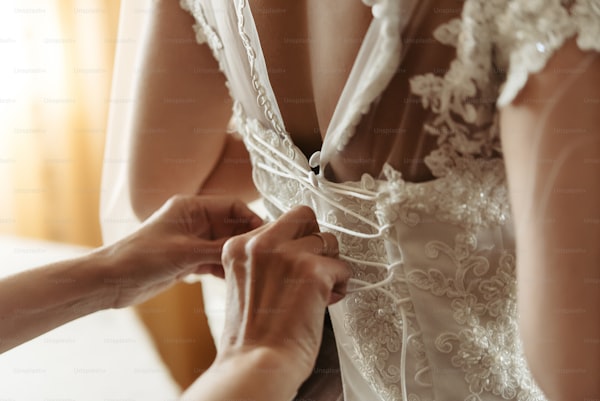Mastering Wedding Dress Alterations: A Detailed Guide for Delicate Tulle Overlays
Mastering Wedding Dress Alterations: A Detailed Guide for Delicate Tulle Overlays
Every bride dreams of her perfect wedding dress, and for many, that dream is adorned with a delicate tulle overlay. However, when it comes time for alterations, you may find yourself asking the question: How do you handle alterations for a wedding dress with a delicate tulle overlay? In this comprehensive guide, we will explore the intricacies of altering Wedding dresses featuring tulle, common problems, expert tips, and essential considerations that brides should keep in mind.
Understanding the Tulle Overlay
Tulle is a lightweight, sheer fabric that adds a magical touch to any wedding dress. Its ethereal quality can enhance the beauty of the dress but also makes alterations challenging. Tulle can be sensitive and prone to fraying, which requires precision during the alteration process.
Common Challenges with Tulle Overlays
When handling a wedding dress with a delicate tulle overlay, there are several challenges that can arise. Here are the most common:
- Fraying Edges: Tulle is prone to fraying, particularly if it is cut incorrectly. This can lead to uneven hems and a less-than-polished look.
- Shifting Layers: The lightweight nature of tulle can cause it to shift during alterations, leading to unevenness or excess tension.
- Maintaining Shape: Alterations need to preserve the original style and shape of the dress while ensuring a perfect fit.
Steps to Handle Alterations on Tulle Overlays
Now that we have discussed the challenges, let’s delve into the steps required to alter a wedding dress with a delicate tulle overlay.
1. Consult with a Professional
The first step in altering any wedding dress should always involve consultation with a professional bridal tailor. Their expertise is crucial for handling delicate fabrics like tulle. They can assess the dress and suggest the best course of action.
2. Make a Plan
After consulting with the tailor, it’s important to make a detailed plan for the alterations. This includes determining whether the changes will be made to the base layer or the tulle overlay itself. Discuss the desired length, fit, and any additional design changes.
3. Pinning and Marking the Tulle
During the fitting process, the tailor will pin the tulle in place. This step is essential to visualize how the alterations will look. It's important to ensure the pins are positioned carefully to avoid any shifting of the fabric.
4. Cutting and Hemming
When it's time to cut the tulle, the tailor should take extra precautions to minimize fraying. Using a rotary cutter or sharp scissors can help achieve a clean edge. After cutting, the hem can be finished using a specialty stitch that prevents the material from unraveling.
5. Layer Management
For dresses with multiple layers, managing each layer during the alteration process is vital. If the tulle sits over a structured fabric, alterations need to align perfectly for a seamless appearance. Expert seamstresses often recommend layering strategies that maintain the integrity of the wedding dress.
| Common Tulle Overlay Alteration Techniques | Description |
| Hemming | Finishing edges to prevent fraying and ensure a polished look. |
| Taking in | Adjusting the fit by sewing the tulle overlay closer to the base layer. |
| Adding bustles | Creating a bustle allows the bride to manage the train while dancing. |
Tips for Success
When handling alterations for tulle overlays, keep the following tips in mind:
- Schedule Early: Book your alteration appointments well in advance of the wedding day, as delicate alterations can take time.
- Test the Fit: Always do multiple fittings to ensure the perfect fit and flow of the dress.
- Communicate Clearly: Clear communication with your tailor is essential to ensure your vision is achieved.
Common Questions and Concerns
Brides often have questions about fabric care and alteration logistics. Here are some frequently asked questions:
- Can I alter the dress myself? It is not recommended to alter tulle by yourself due to its delicate nature. Seek professional assistance.
- How much do alterations cost? The cost can vary widely depending on location, complexity, and fabric. Expect to pay between $100 to $500 for comprehensive alterations.
- How long will the alterations take? Typically, start to finish alterations can take anywhere from 4 to 8 weeks, depending on the tailor’s schedule.
Conclusion
In conclusion, altering a wedding dress with a delicate tulle overlay is a process that requires careful planning and expert execution. By consulting a professional tailor and understanding the essential steps involved, brides can ensure their dream dress fits perfectly while maintaining its elegance. Remember, the goal is to celebrate your special day while looking and feeling your absolute best. Always communicate your needs clearly and give your tailor plenty of time to work their magic.
As you prepare for your big day, take these suggestions to heart and enjoy the journey towards walking down the aisle in your stunning wedding dress. Happy planning!

